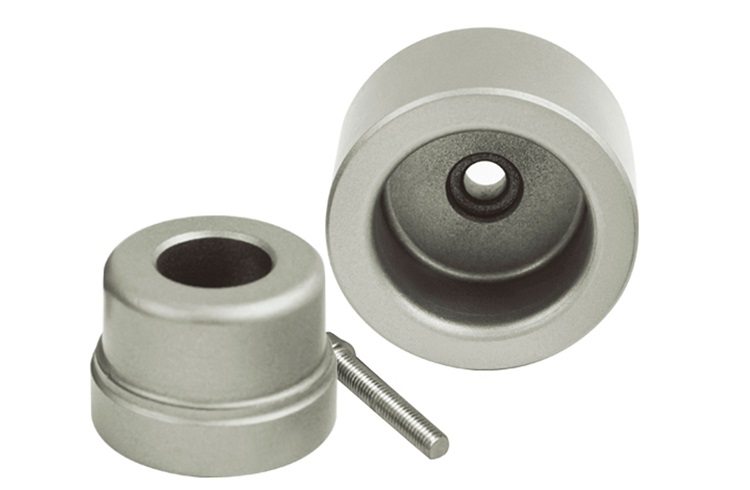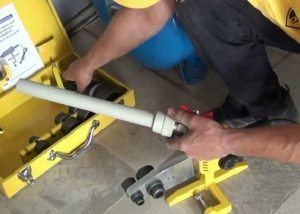Installation of polypropylene pipes, unlike metal, differs in some complexity. If only special pipe cutters (special scissors) can come in handy when mounting a steel pipeline, laying of PP pipes It is necessary to use additional devices, namely soldering irons for polypropylene pipes.
Content
- 1 Types of Soldering Iron
- 2 What to look for when buying a kit for soldering polypropylene pipes
- 3 How to choose a nozzle for a soldering iron
- 4 Thermal power and design features of the welding machine
- 5 How to prepare polypropylene pipes and fittings for the welding process
- 6 A few recommendations for welding polypropylene pipes
Types of Soldering Iron
Welding soldering irons for soldering polypropylene pipes are represented by conventional electric heaters, an automatic regulator is built inside them, which monitors and regulates the temperature of the solder. The main task of the soldering irons for welding, which are used when installing the pipeline, is to maintain the required temperature for heating the working surface, namely 260 degrees.
Soldering irons for polypropylene pipelines consist of a body and a handle. Inside the housing are electrical parts that ensure stable operation. At the front of the apparatus is a heater to which working nozzles are attached. The nozzles themselves change depending on the diameter of the pipes. Regardless of the type, all soldering iron devices for polypropylene pipes work on the same principle. First, the element heats the surface of the pipe to a temperature that is set on the thermostat, then turns off. If you can not choose irons for soldering polypropylene pipes, which is better than others, remember that the indicators for different jobs change.
Advice! The selected tool for soldering polypropylene pipes will not be able to improve or degrade the quality of work. The result depends on the welding conditions and experience. Buying a particular soldering iron is most often based on personal preferences.
In some models of soldering irons for welding polypropylene pipes when cooling by no more than 5 degrees, the electronic circuit or thermostat again turns on the heater to the maximum temperature. Consumers have access to devices for soldering polypropylene pipes, which differ in the type of their heating element, namely:
- soldering irons for pipes made of polypropylene with a cylindrical heater, nozzles on the heater are put on like a pipe clamp;
- soldering irons with a heater that looks like a flat plate. On the plate there are holes for attaching nozzles. Because of this type of soldering iron, it can also be called an “iron” for soldering polypropylene pipes.
In stores you can find domestic and foreign devices. But it is important to pay attention to quality and cost, and not just to the country of manufacture.
What to look for when buying a kit for soldering polypropylene pipes
The purchase of a soldering iron of polypropylene pipes is based on three indicators:
- the cost of the device for welding;
- soldering iron thermal power;
- the shape of the heating element (iron or cylinder).
Depending on the cost, the choice of soldering irons for polypropylene pipes is presented in three categories:
- a set of soldering irons of the budget segment - Chinese and domestic production;
- Turkish kits are slightly more expensive;
- the most expensive sets of soldering irons - European manufacturers. German and Czech are especially popular.
Before deciding which soldering irons for polypropylene pipes are better, you need to understand for whom it is purchased.
If you need to assemble a polypropylene pipeline at home - you should pay attention to the equipment of the first segment. The safety margin of the parts of such sets will cope with the installation of two complete pipeline systems, regardless of whether the cylinder or iron is used as a heating element. The device is easy to operate and can then be used for partial installation or minor repairs (for example, welding of a pipe section).
Advice! If soldering a pipeline for you is a source of income, and not a one-time need, then you need to purchase an iron made in Europe.
The main difference between Chinese equipment for soldering polypropylene pipes from Czech is not in the reliability of the components, but in its ability to maintain the temperature at the initially set level. After some time, the error rate of Chinese soldering irons reaches ten degrees, because of which the integrity of the seam is violated, which cannot be visually checked immediately after welding.
At the beginning of his career, a beginning master will use a device for soldering polypropylene pipes from Turkish manufacturers of the middle price segment. Even after several months of active use, the amplitude of the error is only a couple of degrees. In terms of cost and final quality of welding, a shift worker is much more profitable to buy and use two or three Turkish soldering irons than one German-made device.
It is advisable for employees of the company who are constantly involved in the installation and repair of the propylene pipeline to buy an expensive high-quality soldering iron for welding pipes. It is able to work much longer without deviations in the soldering temperature. Therefore, German products are recognized as the best for polypropylene pipes.
Following the recommendations, it is easier to determine which soldering iron to choose for a polypropylene pipe.
How to choose a nozzle for a soldering iron
When choosing a nozzle for a soldering iron, when working with polypropylene pipes, you must pay attention to:
- soldering iron performance - the lower it is, the smaller the diameter for the nozzle is taken;
- volume of work of the performer. It will not be difficult for professionals to use both 10 mm nozzles and 110 mm nozzles when working. To mount a home pipeline on your own, you may need only three nozzles - 16 mm, 24 mm and 32 mm;
- design features. The highest quality nozzles are made with Teflon coating and from materials with good heat conductivity.
A high-quality coating of the nozzle will provide easy removal of the heated part without its adhesion and deformation.
Important! A soldering iron with low power will not be able to warm up a large nozzle. Before buying, you must make sure that the size range of the nozzle corresponds to the indicated power of the soldering iron.
Even when installing a home pipeline, you should not save money and purchase low-quality nozzles, as they can damage the pipes when soldering, and you will lose some of the materials.

When purchasing additional nozzles for a soldering iron, pay attention to the correspondence of their size and power of the device
Thermal power and design features of the welding machine
High performance of equipment is not an indicator of its high-quality soldering.It is necessary to decide what power will be optimal during operation. In order to choose a soldering iron with the required power, first you need to familiarize yourself with the diameter of the pipes that need to be soldered. The higher the pipe diameter, the higher the power of the soldering iron. When buying an iron for soldering polypropylene pipes, do not forget about the recommended gradation:
- pipe diameter from 16 to 63 mm - the power of the soldering iron should be 680 W;
- pipe diameter from 16 to 75 mm - the power of the soldering iron should be 850W;
- pipe diameter from 125 mm - the power of the soldering iron should not be lower than 1200W.
To mount a propylene pipeline for heating in a private house, with a pipe diameter of 50 mm, it is enough to use a welding machine with a power of 700 watts.
Advice! When working in hard-to-reach places, it is necessary to work using one nozzle, so a cylindrical soldering iron will help in such situations. This design will fit the nozzle to the very edge of the heating element.
When choosing a device, do not forget about its weight. Since all work is carried out far from the most comfortable conditions, the soldering iron must be kept on weight, while regularly removing and putting on various parts. Hands in this position beginners quickly numb and the possibility of getting burned increases significantly. It is worth remembering this, then the question: “How to use soldering irons for polypropylene pipes?” will not torment you.
How to prepare polypropylene pipes and fittings for the welding process
The main and first stage of preparing both pipes and fittings for the welding process is the degreasing of all surfaces that come into contact with each other. Those pipes that are reinforced with aluminum are prepared as follows. When the aluminum layer is located close to the surface (immediately below the decorative polypropylene), the reinforcing layer is removed from the ends of the pipe using a shaver using a stripping method. This is necessary to ensure a quality connection.
When the reinforcing layer is located in the center of the walls of the polypropylene pipes, preparation for soldering is carried out with a special tool that will allow you to cut the ends of the pipe together with the protruding aluminum layer. In rare cases, in the preparation of polypropylene pipes, couplings are used that can provide enveloping of the pipe edges with polypropylene, which is necessary to impart tightness when welding parts.
A few recommendations for welding polypropylene pipes
First you need to prepare the polypropylene pipes themselves. Soldering irons also need some preparation. In order for the pipes and couplings to be connected without distortions, marks are applied to the pipes with a simple pencil. If the fitting was welded with bumps, it is cut off. The whole welding procedure starts over with the help of new parts.
Do not know how to use irons for polypropylene piping with vertical soldering? Work must be carried out in pairs - one worker holds the pipe in its original position, the second carries out welding work. Before each subsequent part, it is necessary to remove residual propylene from the working surface of each nozzle.
Advice! When fastening, in no case do you need to rotate the parts - this will not strengthen them, but rather weaken the welding layer.
The process of soldering a polypropylene pipe and fitting is quite simple, every beginner can handle it. You should adhere to the given sequence:
- preparation of the pipe for soldering - the pipe is evenly cut, cleaned, if necessary, part of the aluminum foil is removed;
- then the soldering iron is turned on and the temperature on the soldering iron thermostat is adjusted;
- a full indicator of the soldering iron is indicated by a light indicator;
- then it is necessary to put the pipe and propylene fitting from different sides on the soldering nozzle;
- after a few seconds (the duration varies depending on the thickness of the pipe), the parts are carefully removed from the nozzle of the tool for soldering polypropylene pipes;
- details are connected. The fitting is immersed in the pipe to the previously drawn mark.
When fulfilling all the recommendations, you will know not only how to choose a soldering iron for polypropylene pipes, but also get a high-quality seam at the end of welding.










